How Artificial Intelligence is Revolutionizing the Retail Experience

Imagine walking into a store where you always find what you need quickly. You see this change because artificial intelligence is revolutionizing retail. Walmart now uses ai to process over 850 million product data points, making it easier for you to find the right item. Stores use ai to give you better product recommendations and improve your customer experience. The digital transformation in retail helps businesses and customers every day. Check out these numbers showing how ai changes retail:
Metric/Segment | Statistic/Value | Year/Period |
|---|---|---|
Global AI in Retail Market Size | 2024 | |
Projected Market Size | USD 40.74 billion | 2030 |
CAGR | 23.0% | 2025-2030 |
Key Takeaways
AI personalizes your shopping by learning your preferences, making product suggestions, and offering better deals that boost satisfaction and sales.
Smart tools like chatbots and virtual assistants give you quick help anytime, improving your shopping experience and saving stores money.
AI helps stores keep products in stock and predict what you will want next, so you find what you need without delays or empty shelves.
New technologies like smart checkout, visual search, and augmented reality make shopping faster, easier, and more fun.
Top retailers use AI to improve service, cut costs, and grow sales, showing that AI is shaping the future of retail for everyone.
AI and Customer Experience
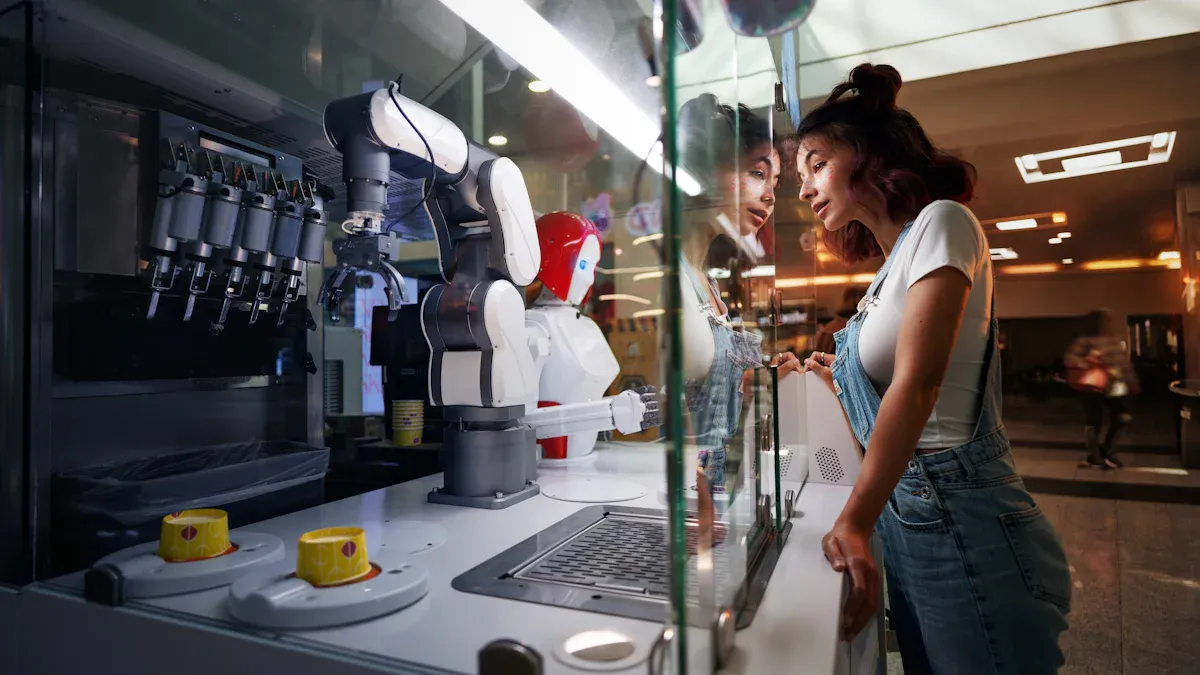
Personalization
You notice how stores seem to know what you want before you even ask. This is not magic. It is artificial intelligence and ml working together to create a personalized shopping experience for you. AI uses data from your past purchases, browsing habits, and even your clicks to understand your preferences. With advanced analytics and machine learning, retailers can offer you customized selections that match your style and needs.
Did you know? AI-driven personalization can boost customer satisfaction by up to 30% and increase sales by about 20%. Retailers see a 2× higher engagement rate when they use ai for personalization.
AI and ml analyze huge amounts of customer data, such as purchase history and online behavior. This helps retailers deliver personalized product recommendations and special promotions just for you. Dynamic pricing models powered by ai adjust prices in real time, making sure you get the best deals based on demand and inventory. Visual search and virtual try-on tools also make your shopping easier and more fun, increasing your confidence and reducing returns.
Metric / Benefit | Data / Statistic |
|---|---|
Up to 25% increase reported by marketers using AI personalization | |
Sales uplift | Approximately 20% sales increase attributed to AI-driven personalization |
Customer engagement | 2× higher engagement rates with AI personalization |
Conversion rates | 1.7× higher conversion rates in marketing campaigns |
Customer churn reduction | 28% reduction in churn linked to AI personalization |
Customer satisfaction boost | Up to 30% increase in satisfaction scores |
Revenue from AI recommendations | 35% of Amazon’s revenue comes from AI-based product recommendations |
Cost efficiency | Up to 50% reduction in customer acquisition costs; 37% decrease in marketing costs reported |
Industry adoption | 59% of marketers currently use AI for personalization; 80% believe AI will revolutionize marketing by 2025 |
You benefit from real-time personalization across all retail touchpoints. This means you get seamless, relevant interactions every time you shop. AI and ml help retailers predict what you want, making your experience smoother and more enjoyable.
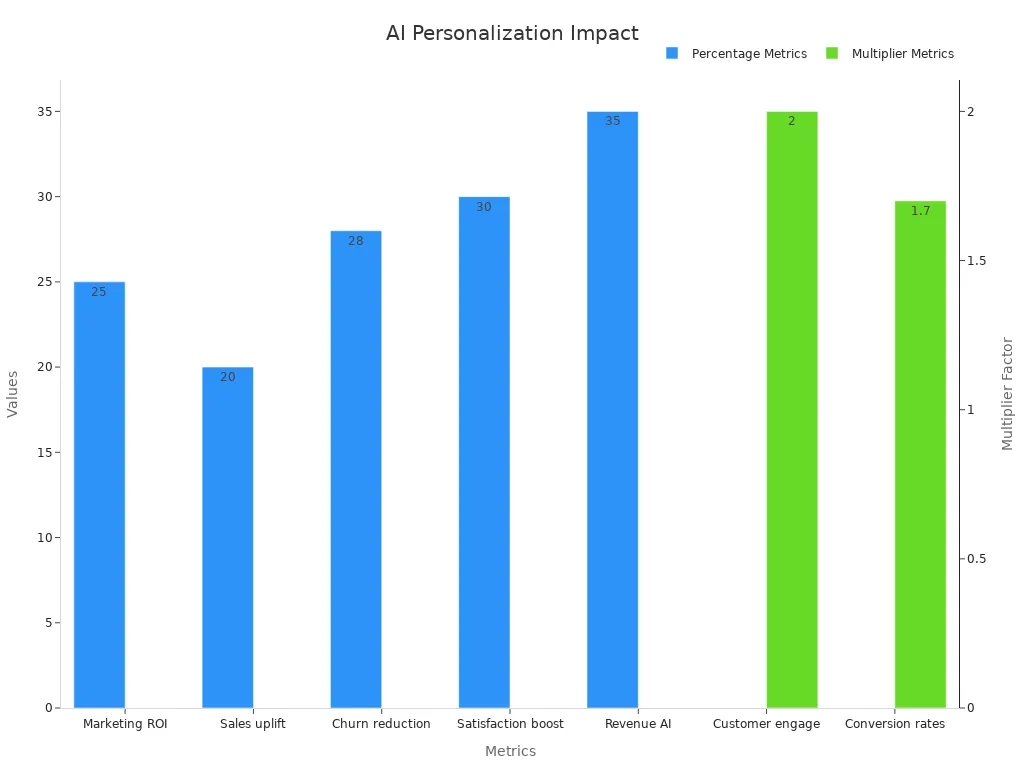
Product Recommendations
When you shop online, you often see suggestions like "You may also like" or "Customers who bought this also bought." These personalized product recommendations come from powerful ai and ml algorithms. They use customer insights from your browsing and buying patterns to suggest items you are likely to love.
AI-driven product recommendations can boost sales by up to 30%.
AI algorithms analyze customer behavior and purchase history to personalize suggestions.
Personalized recommendations improve customer experience and loyalty.
AI increases click-through rates and conversion rates, directly impacting revenue.
AI enables scalable personalization for millions of customers at once.
Retailers like Amazon use ai to power their recommendation engines. Nearly 35% of Amazon’s revenue comes from these systems. You get more relevant choices, and retailers see higher engagement and sales. In fact, almost 50% of US shoppers in 2023 wanted personalized product recommendations. When you receive these suggestions, you are more likely to return to the store and make repeat purchases.
Metric Description | Quantitative Impact |
|---|---|
Increase in marketing ROI | 10-30% |
Reduction in customer acquisition costs | 50% |
Revenue improvement | 5-15% |
E-commerce revenue from personalized recommendations | Over 30% |
Amazon revenue from recommendation engine | Nearly 35% |
Projected market size for personalization software by 2026 | $11.6 billion |
Targeted Marketing
AI and ml have changed how retailers reach you with marketing messages. Instead of sending the same ad to everyone, ai uses analytics and customer journey analysis to create targeted marketing campaigns. These campaigns use data to segment customers into groups based on interests, habits, and needs.
Metric | Improvement/Impact | Source/Example |
|---|---|---|
25% average increase using AI vs traditional methods | McKinsey, 2021 | |
30% increase in 3 months for an e-commerce retailer | Case study example | |
30% increase reported by Adidas with AI personalization | Harvard Business Review, 2022 | |
Customer Segmentation | Up to 15x more actionable segments identified by AI | Salesforce Research, 2022 |
Engagement Rate | 38% higher engagement with AI-refined segmentation | Epsilon, 2021 |
Cost per Acquisition | 30% reduction using Google's AI Smart Bidding | Google, 2022 |
Customer Acquisition Cost | 15-20% reduction with AI targeting (Adore Me) | Forbes, 2021 |
Return on Ad Spend (ROAS) | 30% increase (Adore Me) | Forbes, 2021 |
Marketing ROI | 22% average increase using AI for advertising optimization | Deloitte Digital, 2022 |
You receive ads and offers that match your interests, which makes you more likely to engage and buy. AI-powered marketing also helps retailers lower costs and improve their return on investment. With better customer insights and analytics, retailers can create messages that speak directly to you, making your shopping experience more personal and enjoyable.
Tip: When you see ads that feel like they were made just for you, that is ai and ml at work, using data and analytics to improve your customer experience.
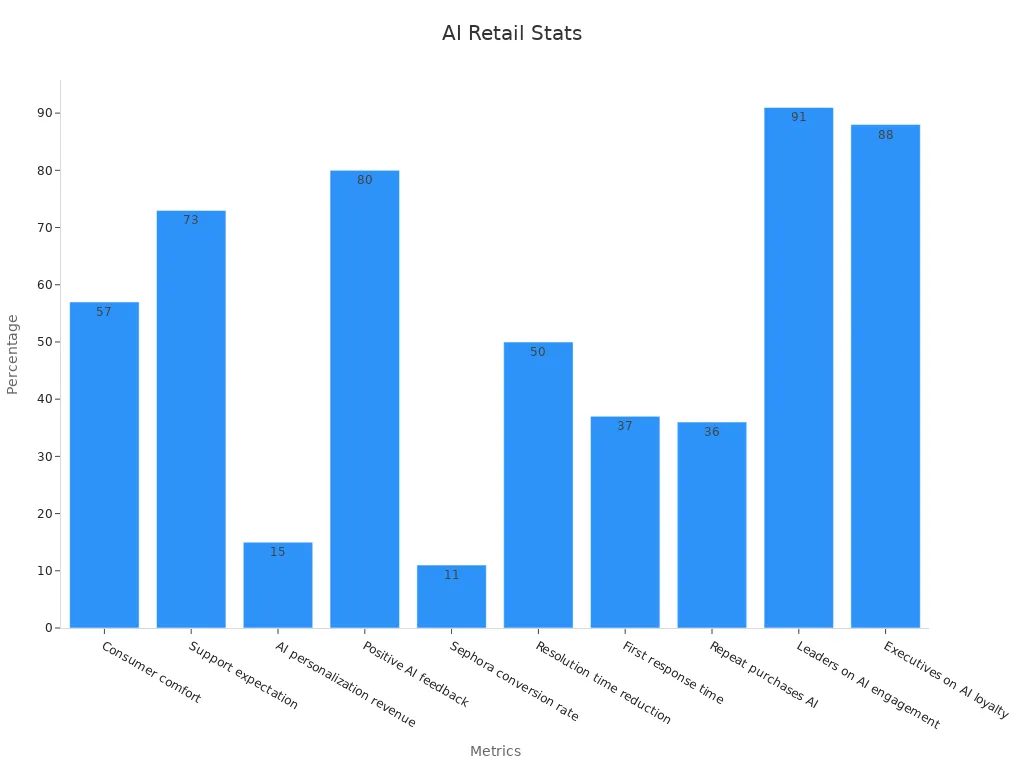
Revolutionizing Retail Service
Chatbots and Virtual Assistants
You see chatbots and virtual assistants everywhere in retail today. These tools use ai to answer your questions, help you find products, and even track your orders. When you shop online, you might chat with an ai assistant that gives you instant answers. This makes your shopping faster and easier.
H&M uses chatbots and virtual assistants to give you personalized product suggestions, sizing help, and real-time order updates. This leads to more sales and happier shoppers.
Amazon’s Alexa lets you shop with your voice. You can ask for product details or get support without typing.
Walmart’s ai chatbots handle simple questions, so employees can focus on more complex tasks. This improves your shopping experience.
Over 92% of businesses use ai-driven personalization to grow faster.
73% of shoppers feel comfortable using chatbots and virtual assistants for customer service.
These tools can handle many conversations at once, so you never have to wait long for help.
Chatbots and virtual assistants reduce costs for retail stores by automating routine questions. They also boost sales by giving you quick, personalized responses. The global chatbot market keeps growing, saving companies billions each year.
Automated Support
Automated support powered by ai changes how you get help in retail. When you have a question, ai can sort and send your request to the right person. This means you get answers faster and with fewer mistakes.
Studies show that ai-driven help desks cut response times by using smart ticketing and routing. Ai agents work 24/7, so you get support any time, day or night. Companies use ai to track how fast they answer questions and how happy customers feel after getting help. These numbers show that ai makes support quicker and more accurate.
Automated ticketing systems sort your questions and send them to the right expert.
Ai agents give instant answers to common questions, so you do not have to wait.
Smart routing and templates make sure you get clear, fast replies every time.
With ai, retail stores can help more people at once and improve the customer experience. You get the support you need, when you need it, making shopping smoother and more enjoyable.
Retail Operations and Efficiency
Artificial intelligence changes how you experience retail behind the scenes. You see faster service, better product availability, and lower prices because of smarter operations. AI, machine learning, and advanced analytics help retailers improve efficiency, cut costs, and support sustainability. You benefit from these improvements every time you shop.
Inventory Management
You want your favorite products to be in stock when you visit a store or shop online. AI and ml make this possible by tracking inventory in real time. These systems use data from sales, shipments, and even weather to predict what you will buy next. Retailers use predictive analytics to avoid running out of popular items and to reduce waste from unsold goods.
Target’s AI-driven Inventory Ledger shows how powerful these systems can be. It processes up to 360,000 inventory transactions per second and handles 16,000 inventory position requests per second across 2,000 stores. This scale means you get better stock control, fewer empty shelves, and less deadstock. AI and ml also help retailers manage cash flow by keeping just the right amount of inventory on hand.
You can see the impact of AI in inventory management in the table below:
Metric Description | Numerical Improvement |
|---|---|
Up to 95% | |
Reduction in manual inventory management time | 65 hours per week |
Reduction in lost sales and product unavailability | Up to 65% |
Warehousing cost reduction | 5-10% |
Administration cost reduction | 25-40% |
AI and ml automate routine inventory tasks, so employees can focus on helping you. This automation leads to better data accuracy and faster restocking. You get a smoother shopping experience with fewer out-of-stock surprises.
Demand Forecasting
You might wonder how stores know what products you will want next season. AI and machine learning use data from past sales, promotions, and even social trends to predict future demand. This process, called demand forecasting, helps retailers plan smarter and avoid overstock or shortages.
AI-powered demand forecasting uses several accuracy metrics to measure performance. These include MAE (Mean Absolute Error), RMSE (Root Mean Square Error), BIAS, and Percentage Error (PE). Retailers often use these metrics together to get a full picture of forecast accuracy. AI and ml models adjust for seasonality and outside factors, so you get the right products at the right time.
Retailers use MAE, RMSE, BIAS, and PE to track forecast accuracy.
AI and ml models update forecasts automatically as new data comes in.
These systems alert managers if accuracy drops, so they can act fast.
Forecasting tools like LEAFIO AI help retailers make data-driven business decisions and respond quickly to changes in demand.
AI and ml models balance accuracy and reliability, so you get consistent product availability.
Forecast accuracy depends on the type of product and how stable demand is. AI and ml models work best when they use advanced data and predictive analytics to spot trends and adjust for promotions or holidays. This approach helps retailers make better data-driven business decisions and keeps shelves stocked with what you want.
Supply Chain Optimization
You may not see the supply chain, but it affects every part of your shopping experience. AI, ml, and predictive analytics help retailers move products from factories to stores more efficiently. These tools use data to plan routes, manage suppliers, and predict delays before they happen.
Studies show that AI improves demand forecasting and inventory optimization, which reduces stockouts and surplus inventory. Machine learning and predictive analytics make the supply chain more resilient and efficient. Retailers use AI to choose better suppliers, cut costs, and improve quality. AI-powered predictive analytics also help reduce disruptions and improve responsiveness to market changes.
Belhadi et al. (2021) show that AI reduces stockouts and surplus inventory.
Samuels et al. (2024) find that AI and predictive analytics boost supply chain resilience and efficiency.
Eyo-Udo (2024) reports better supplier selection and lower costs with AI.
Elufioye (2024) highlights improved supply and fewer disruptions.
Muthaluri (2024) documents higher efficiency in warehouse operations.
Richey (2023) shows AI streamlines logistics and boosts efficiency.
Adenekan (2024) finds less waste and better market response with AI-driven inventory optimization.
You can see the cost savings and adoption rates in the table below:
Statistic Description | Value/Projection |
|---|---|
Amazon's fulfillment cost reduction through AI and robotics | |
Retailers reporting AI helped reduce annual operational costs | 94% of surveyed retailers |
Projected adoption of AI solutions in warehouses by 2027 | 50% of companies |
AI and ml help retailers automate tasks like order tracking, shipment planning, and pricing optimization. This automation frees up employees to focus on strategy and customer service. You benefit from faster deliveries, lower prices, and more sustainable practices.
Tip: AI and machine learning in the supply chain mean you get your products faster and with fewer errors. Retailers save money and reduce waste, which helps the environment.
In-Store AI Innovations

Smart Checkout
You can now check out faster than ever before, thanks to ai-powered smart checkout systems. These systems use sensors, cameras, and ai to let you pay without waiting in line. When you use a smart cart, it tracks your items and processes your payment automatically. This technology makes shopping more convenient and helps stores run more efficiently.
Here are some ways smart checkout improves your experience:
Metric / Example | Description |
|---|---|
Smart carts increase consumer basket sizes by up to 30% through personalized recommendations. | |
Labor Cost Reduction | Payments processed by smart carts reduce labor costs by minimizing the need for checkout staff. |
Convenience & Checkout Speed | Eliminates checkout lines by enabling automatic payment via cart sensors and stored payment info. |
Kroger (KroGo carts) | Smart carts with built-in scales and cameras for quick shopping and checkout. |
Wegmans (Shopic AI clip-on) | AI-powered clip-on unit for product identification and pricing on ordinary carts. |
Amazon (Dash Cart) | Sensor and computer vision-enabled carts that automatically bill customers, bypassing lines. |
You benefit from less waiting and a smoother shopping trip. Stores also use ai to track inventory and prevent theft, making the whole retail process smarter.
Tip: RFID and sensors in smart checkout systems help stores keep shelves stocked and reduce losses.
Visual Search
Visual search lets you find products by taking a picture instead of typing keywords. With ai, you can snap a photo of an item and instantly see similar products in the store or online. This technology makes shopping easier, especially if you do not know the product name.
Aspect | Evidence |
|---|---|
Market Revenue Share (Image Search Segment) | 62.1% in 2025, showing image-based visual search leads in retail and e-commerce |
User Engagement | Visual search improves product discovery and boosts sales and engagement |
Platform Examples | Pinterest and Instagram use visual search to help you find and buy similar products |
Technology Integration | AI and AR work together to increase engagement and conversion rates in retail visual search |
You see ai-powered image recognition in many retail apps. These tools help you discover new products and make shopping more fun. Retailers use visual search to attract younger shoppers and keep you engaged.
Mobile visual search is growing fast because of better smartphone cameras.
Social media platforms turn images into shopping opportunities with ai.
Augmented Reality
Augmented reality (AR) uses ai to blend digital images with the real world. You can try on clothes virtually or see how furniture looks in your home before you buy. This technology helps you make better choices and reduces returns.
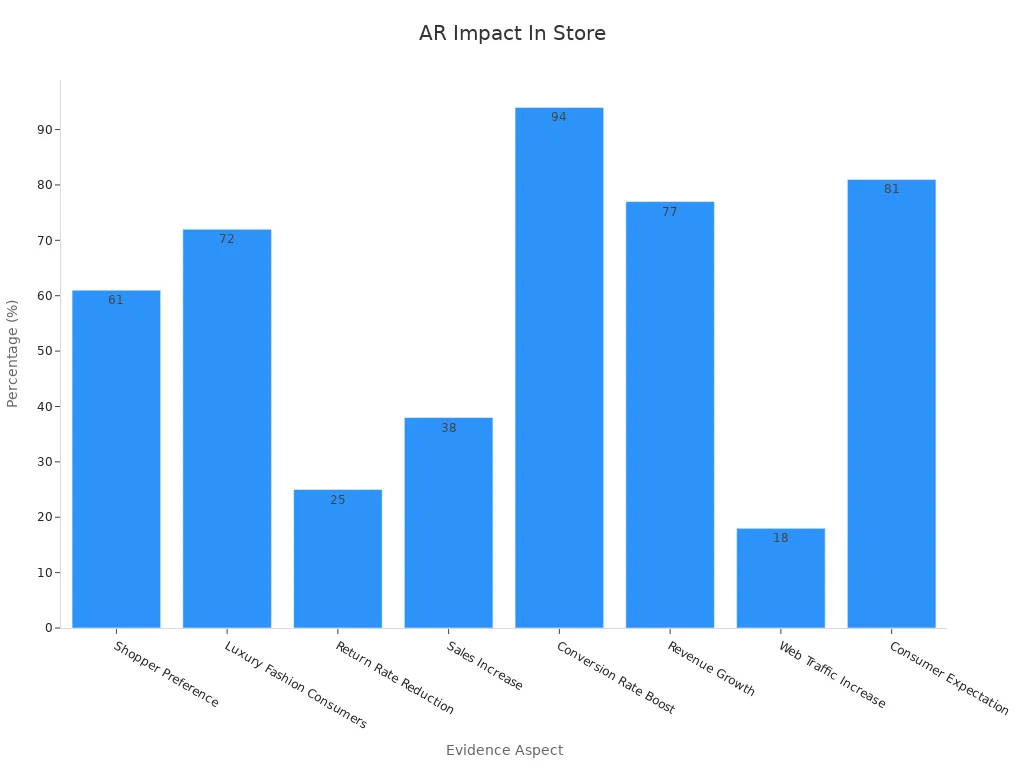
Recent studies show that 61% of shoppers prefer stores that offer AR experiences. Luxury retail brands see even higher demand, with 72% of their customers valuing AR. Brands using virtual fitting rooms report a 25% drop in returns. Some stores, like John Lewis, have seen sales rise by up to 38% after adding virtual try-on technology.
You can expect more ai and AR features in retail as younger shoppers look for interactive and personalized experiences. These tools make shopping more engaging and help you feel confident about your purchases.
AI Success Stories in Retail
Leading Retailers
You see many top retailers using ai and ml to transform how you shop and how stores operate. These companies use data and artificial intelligence to improve the customer experience, boost sales, and make smarter decisions. Here are some examples:
Kaya uses Microsoft Dynamics 365 and Power BI to improve supply chain visibility and planning. This helps you find products in stock more often.
Lenovo increased agent productivity by 15% and reduced handling time by 20% with Dynamics 365. You get faster support and higher satisfaction.
Mania de Churrasco boosted sales by 20% year-over-year by using Microsoft Azure and Power Platform for better data intelligence.
Moneyview improved operational efficiency by 35% and team productivity by 30% with Azure OpenAI Service models.
Narayana Health reduced medical record coding errors by 40% using a GPT-4 powered bot.
You can see how these retailers use ai and ml to turn data into better results for both you and their teams.
Metric / Outcome | Value / Impact | Description / Source |
|---|---|---|
AI Adoption Rate | Significant increase from 48% in 2019 (IBM, 2023) | |
Revenue Increase | 19% average uplift | Reported by McKinsey Global Survey (2022) |
Stockouts Reduction | 30% decrease | AI-driven inventory management |
Excess Inventory Reduction | 25% decrease | Inventory optimization benefits |
Forecasting Error Reduction | 20-50% decrease | Improved demand forecasting accuracy |
Annual Savings for Mid-sized Retailers | $3 million | Cost savings from AI inventory and supply chain management |
Customer Service Improvements | 82% faster resolution, 47% cost reduction | AI assistants improve efficiency and satisfaction |
Checkout Time Reduction | 75% faster automated checkout | Computer vision applications |
Delivery Cost Reduction | 15-30% reduction | Route optimization via AI |
Labor Cost Savings | 8-15% reduction | Dynamic labor scheduling |
Energy Cost Reduction | 10-20% reduction | AI-driven energy management |
Supply Chain Resilience | 61% better disruption mitigation | AI-enhanced supply chains (McKinsey, 2022) |
Real-World Impact
You notice the real-world impact of ai and ml every time you shop. Retailers use data and competitive analysis to improve your experience and make their businesses stronger. Many stores report higher revenue, lower costs, and better customer engagement after using artificial intelligence.
Metric / Example | Description / Statistic |
|---|---|
Revenue Increase | 69% of retailers report increased annual revenue after AI adoption. |
Operating Cost Reduction | 72% of retailers using AI experienced decreased operating costs. |
Financial Forecast | McKinsey projects an additional $310 billion in retail revenue from AI-enhanced digital customer interactions. |
AI Adoption Rate | 87% of retailers have deployed AI in at least one business area. |
Future Adoption Expectation | 80% of retail executives expect AI automation adoption by end of 2025. |
Starbucks AI Use | AI powers personalized loyalty programs, increasing repeat visits and brand loyalty. |
Walmart AI Use | AI-driven gifting recommendations, enhanced search, and robotic inventory management improve shopping experience and operational efficiency. |
Zara AI Use | AI predicts fashion trends, enables dynamic pricing, and optimizes inventory management. |
Amazon Go AI Use | AI-powered cashier-less shopping with real-time data analysis for product offering refinement. |
Consumer Sentiment | 87% of shoppers who tried GenAI tools are positive about AI's impact; 73% open to AI chatbots; 60% used voice assistants for purchases. |
You can see how ai and ml help retailers serve you better and stay ahead in a fast-changing market. These tools use data to predict trends, manage inventory, and personalize your shopping journey.
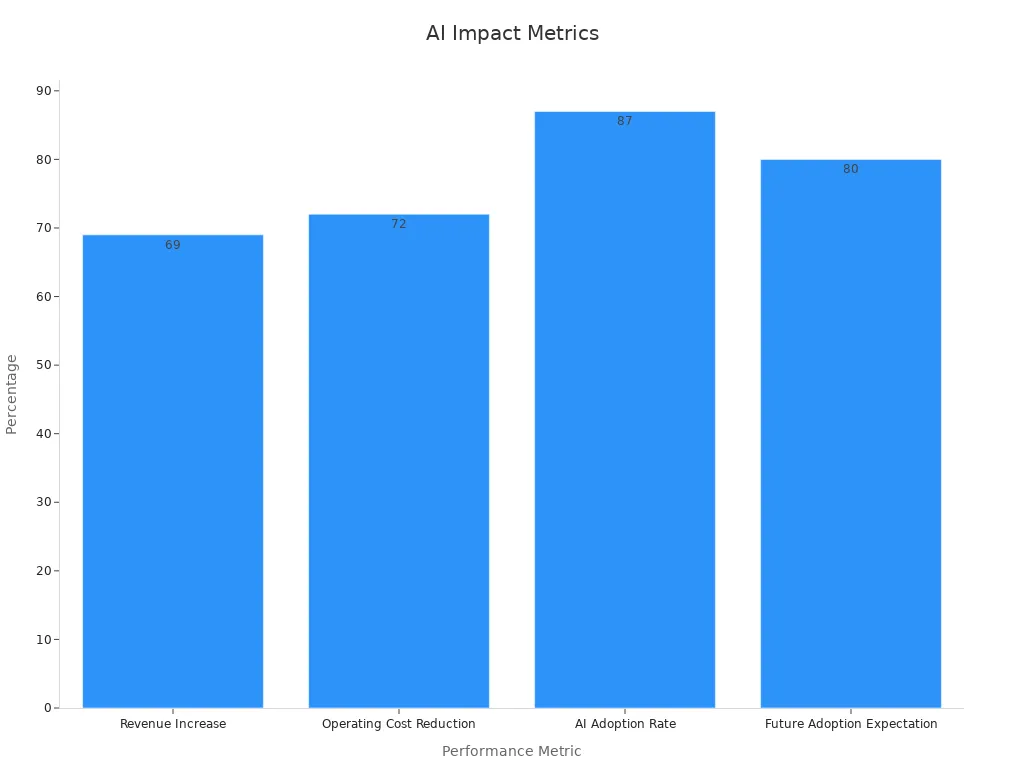
Note: AI and ml continue to shape the future of retail. You benefit from faster service, smarter recommendations, and a more enjoyable customer experience.
The Future of Artificial Intelligence in Retail
Emerging Trends
You will see ai continue to change how you shop and how stores operate. The global ai in retail market is expected to grow from $14.16 billion in 2024 to $76.44 billion by 2033. This rapid growth shows that more people want personalized shopping and faster service. North America leads this trend, with strong technology and many new ideas from top companies.
Many stores now use machine learning, chatbots, and computer vision to help you find products, manage inventory, and even guide you through the store. Generative ai tools are becoming more common for marketing and supply chain tasks. Small and medium-sized businesses can now use these tools, making ai more accessible than ever.
Retailers using generative ai chatbots saw a 15% higher conversion rate during Black Friday.
60% of buyers noticed better demand forecasting and inventory management with ai in 2024.
70% of executives expect to use ai for personalization by 2025.
30% plan to invest in ai to modernize supply chains.
40% want to improve customer engagement with ai and machine learning.
You can expect ai to help create smarter loyalty programs, better online shopping, and more personalized experiences. Many leaders also plan to use ai for dynamic pricing and new ways to earn revenue.
Challenges
You may notice that using ai in retail brings some challenges. Stores face issues with data quality, security, and customer trust. Here are some of the main challenges:
Reluctance to Change: Workers may worry about losing jobs, so clear communication is important.
Inadequate ROI: High costs and unclear plans can lead to poor results; pilot projects help test ideas.
Poor Quality Data: Good data is needed for ai to work well, so stores must check and manage their data.
Skill Gap: Not enough people have ai skills, so training and school partnerships are needed.
Customer Adoption: Some shoppers do not trust ai, so stores must be open about how they use it.
Integration with Existing Systems: Old systems can be hard to update, so custom solutions and training help.
Challenge Category | Description | Example / Data-backed Insight |
|---|---|---|
AI needs accurate data. Poor data leads to bad results. | Amazon’s success comes from strong data systems. | |
Security & Ethical Concerns | Risks include privacy issues and bias. | Regular checks and bias detection build trust. |
Customer Acceptance & Trust | Some customers prefer humans over ai. | Stitch Fix builds trust by explaining how it uses ai and protects data. |
Integration with Systems | Updating old systems is hard and needs training. | Amazon’s robots needed safety rules and training but improved efficiency. |
AI Talent Gap | Not enough skilled workers for ai. | Training and working with schools help fill the gap. |
ROI Challenges | High costs and unclear plans can hurt returns. | Testing ai with small projects first can show if it works before spending more. |
Note: Future research will focus on making ai more transparent, private, and reliable. Training and teamwork will help solve many of these challenges.
Artificial intelligence changes how you shop and how stores work. You see faster service, smarter choices, and better customer support. Many reports show that AI helps automate tasks, improve decision-making, and create new ways to serve the customer.
AI tools help store teams work smarter and give you a better experience.
Stores use AI to manage inventory, reduce waste, and design better layouts.
Experts believe AI will keep growing and bring even more changes to retail.
Stay curious and watch how these new tools shape your shopping journey.
FAQ
What is artificial intelligence in retail?
Artificial intelligence in retail uses smart computer programs to help stores make better decisions. You see AI when stores suggest products, manage inventory, or use chatbots to answer your questions.
How does AI improve your shopping experience?
AI gives you personalized recommendations, faster checkout, and better customer support. You find what you want quickly. Stores use your shopping data to make your experience smoother and more enjoyable.
Are AI-powered chatbots safe to use?
Most AI chatbots protect your information with strong security. You should check if the store explains how it uses your data. Look for privacy policies before sharing personal details.
Can AI help stores save money?
Yes! AI helps stores lower costs by managing inventory, predicting demand, and automating tasks. You benefit from lower prices and better service because stores work more efficiently.
Will AI take away retail jobs?
AI changes some jobs, but it also creates new roles. You may see more people working with technology or helping customers in new ways. Stores need workers to manage and improve AI systems.
See Also
The Future Of Retail Lies In AI-Powered Stores
Transforming Online Store Management With AI E-Commerce Tools
What Retailers Should Understand About AI-Driven Corner Stores
Smart Electronics Vending Machines Changing The Retail Landscape
Grocery Vending Machines Enhancing Accessibility In Modern Retail
